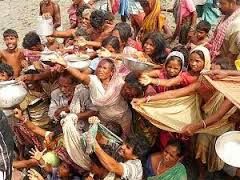 The Asian Development Bank has revised its poverty line to $1.51 per person a day compared to $1.25 by the World Bank, which would push the numbers of poor by 182 million to 584 million in 2010 compared to the WB’s estimates of 402 million.
The Asian Development Bank has revised its poverty line to $1.51 per person a day compared to $1.25 by the World Bank, which would push the numbers of poor by 182 million to 584 million in 2010 compared to the WB’s estimates of 402 million.
ADB’s calculations imply almost half of India’s population (47.7 per cent) was below the line in 2010. Both these estimates are based on the year 2005’s purchasing power parity rates.
A few weeks earlier, the Centre for Global Development’s calculations suggested 102.3 million were poor in India in the same year.
While poverty estimation is undoubtedly a complex exercise, such a sharp difference does raise the inevitable question of how many poor are there in the country.
The difference in these poverty estimates is on account of two factors -- where one draws the poverty line and the PPP estimates used in the process of estimation.
ADB’s latest estimates are based on revising the poverty line upwards from $1.25 to $1.51 per person per day.
Though the regional multilateral agency mainly uses income for calculating poverty, in India it is expenditure that defines the poverty line.
India does not have any official estimates for income distribution.
This revision was carried out on the grounds that the original poverty line was inadequate and did not truly reflect the costs required to maintain a minimum standard of living.
By their estimates, India’s poverty rate rises by 15 percentage points to 584 million in 2010, if compared to the poverty line of $1.25.
CGD’s estimate is based on the latest PPP rates for 2011 released by the International Comparison Program.
Based on the new estimate, not only does the number of poor fall considerably but India emerges as the third largest economy in the world, accounting for 6.4 per cent of world gross domestic product.
While this estimate shows a considerable reduction in poverty, according to Martin Ravallion, senior vice-president at the World Bank, they are puzzling.
For one, Ravallion argues that when a developing country grows, one expects the Price Index to rise.
The PI, basically the ratio of the PPP and the market exchange rate, fell for India from 0.333 in 2005 to 0.324 in 2011; that for China rose from 0.42 to 0.54.
According to Ravallion, as a country grows, so do its real wages, which makes goods that are not traded internationally more expensive.
Simply adjusting the 2005 PPP numbers using India’s GDP deflator (an inflation measure), Ravallion estimates would lead to a higher PI of 0.43.
A higher PI would depress per capita expenditures measured at PPP, translating to a higher estimate of the poor.
Another poverty estimate comes from the Rangarajan committee, which estimated the poverty line for India at Rs 920 (weighted average of rural and urban areas) for 2009-10, estimating the poor at 454.6 million.
At the latest 2011 PPP, this translates to a poverty line of $2.03 per person per day. While, if one takes Ravallion’s estimate of a PI of 0.43, the poverty line stands at $1.53, remarkably close to that used by ADB.
World Bank chief economist Kaushik Basu opines in his blog, “We should simply recognise that PPP has inherent shortcomings and treat statements of country size and power with, let us say, a fistful of salt.”
Surjit Bhalla says there has been a dramatic improvement in poverty alleviation during the recent high-growth period in India.
Regardless of the poverty line used or the region, poverty has declined at about three times the earlier pace, he says in his working paper on Inclusion and growth in India: Some facts, some conclusions’.












 © 2025
© 2025